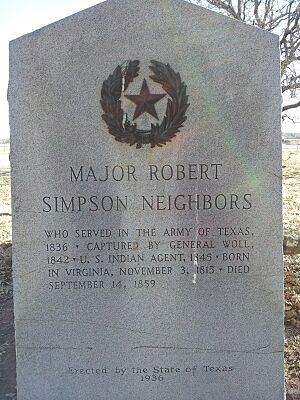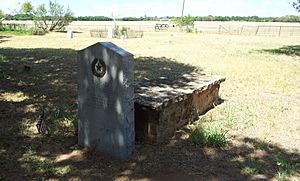Robert Neighbors facts for kids
Robert Simpson Neighbors (born November 3, 1815 – died September 14, 1859) was an important person in Texas history. He worked as an Indian agent, which meant he was a government official who dealt with Native American tribes. He was also a state legislator, helping to make laws for Texas. Robert Neighbors was known for being fair and strong in protecting the rights of Native Americans, especially the Comanches. Sadly, he was killed by someone who disagreed with his views on Native American rights.
Contents
Early Life and Moving to Texas
Robert Simpson Neighbors was born in Charlotte County, Virginia, on November 3, 1815. He was the only son of William and Elizabeth Neighbors. When he was just four months old, both his parents died from pneumonia, leaving him an orphan. He was raised by a guardian, Samuel Hamner, who hired private teachers to educate him.
Joining the Army in Texas
At 19, Robert left Virginia. He soon moved to Texas in early 1836. On January 30, 1839, he joined the Army of the Republic of Texas. He started as a first lieutenant, in charge of Fort Travis on Galveston Island. He later became a quartermaster, managing supplies, and was promoted to captain in 1840. He served in the army until the end of 1841.
Captured by General Woll
On September 15, 1842, Robert Neighbors was in San Antonio. He was part of Captain John C. Hays's group of volunteers. While there, General Adrian Woll invaded Texas and captured San Antonio. Robert Neighbors and about 52 other people were taken prisoner. They were forced to march to Mexico and were held in San Carlos Fortress.
Working as an Indian Agent
Robert Neighbors was released from prison on March 24, 1844, and returned to Texas. He briefly ran a hotel in Houston. Then, on February 12, 1845, he became an Indian Agent for the Republic of Texas.
A New Way to Work with Tribes
Robert Neighbors and Thomas G. Western, who was in charge of Indian Affairs, started a new way of working with Native Americans. It was called the "field system." Instead of waiting for tribes to visit him at his office, Neighbors went directly to their homelands. He met with the Lipan Apaches and Tonkawas where they lived.
After Texas joined the United States, Robert Neighbors helped with an important treaty. This treaty was signed in 1846 between the U.S. government and several tribes, including the Comanches, Ionies, Anadarkos, Caddos, Lipans, Tonkawas, Keechies, Tawacanos, Wichitas, and Wacos. Neighbors even traveled to Washington, D.C., with some Comanche and Anadarko chiefs.
Visiting Tribes in Their Homes
On March 20, 1847, he became a special federal Indian agent. He also helped with the Meusebach-Comanche Treaty in March 1847, which was an agreement between the Comanches and German settlers on the San Saba River.
As a federal agent for the Comanches, he kept up his unusual practice of visiting tribes in their homes. He learned their language and culture. This "field system" was very rare at the time. Because of this, he spent a lot of time far beyond the settled areas. Historians believe he had more influence over Native Americans in Texas than almost any other white person of his time. Besides Sam Houston, he was one of the few white men who bothered to learn the Comanche language and culture, and even traveled into the heart of the Comancheria, the Comanche territory.
Adopted by the Comanche
In 1845, while working as an Indian Agent for the Republic of Texas, Robert Neighbors had a famous meeting with the Penateka Comanche chief, Old Owl. This happened while Neighbors was visiting a Tonkawa camp.
Meeting Chief Old Owl
Chief Old Owl arrived with 40 warriors. He demanded that the Tonkawas feed his war party and their horses, and provide entertainment. The Tonkawas quickly did as he asked, even providing "forty of the best looking Tonkawa maidens." Neighbors, known for being brave, used this chance to meet the Comanches.
When Old Owl met Neighbors, he first complimented Neighbors' nice blue coat. Neighbors understood this meant the chief wanted the coat, so he immediately gave it to him. Other warriors admired his pants, boots, and other clothes. Soon, Neighbors was standing only in a nightshirt!
Becoming Part of the Tribe
Old Owl took a liking to the fearless Neighbors. He told Neighbors that while most white people annoyed him, he liked Neighbors. He invited Neighbors to join his war party. Old Owl even suggested that instead of Neighbors trying to make him a "civilized man," he would teach Neighbors to be a good horse thief and adopt him into the tribe. Neighbors felt this was a rare chance and accepted right away.
The war party went to Mexico. Neighbors tried to buy beef from a ranch, but the Mexicans refused to sell to a Texas official on credit. Old Owl then told them that two cows should be given to them immediately, or the ranch would be burned down and all the cows taken. This worked very well, and the food was given to them right away.
Neighbors left a lasting impression on Old Owl as the first (and only) Texas official to ever ride with a Comanche war party. He thanked them and returned home.
The Neighbors Expedition
In the spring of 1849, Major General William J. Worth of the United States Army asked Robert Neighbors to lead an important trip. The goal was to find a good wagon route between San Antonio and El Paso. General Worth chose Neighbors because he was probably the only person in Texas who could safely travel into the Comancheria.
Mapping a New Route
Neighbors led a group that included soldiers and Texas Rangers, like his friend "Rip" Ford. They successfully mapped a route that later became the path for the Overland Stage Company. This route is still used by highways today. Neighbors reported that the distance between Austin (the state capital) and El Paso was 598 miles, which is the same distance listed today.
For the expedition, Neighbors convinced Buffalo Hump, a Penateka Comanche chief, to guide them. Other Comanche war chiefs, Yellow Wolf and Santa Anna, also joined them. Even after Buffalo Hump left, the group remained under his protection. Another Nokoni Comanche chief, Tall Tree (also known as Guadalupe), led the party the rest of the way to El Paso. Neighbors' ability to talk with the Comanches and his good relationship with them made this important expedition possible.
Indian Reservations in Texas
At that time, jobs like federal Indian Agent often changed depending on which political party was in power. Neighbors was a Democrat, so when the Whig party won the election in September 1849, his job as Indian agent ended. However, Neighbors stayed involved in public life.
Creating Brazos Indian Reservation
He was appointed as a Texas commissioner and helped organize El Paso County in 1850. He also tried to organize counties in New Mexico as part of Texas, but he faced opposition.
From 1851 to 1853, Neighbors was a member of the Fourth Texas Legislature, representing the Bexar and Medina District. With Texas Senator Rip Ford, he supported a plan in 1852 to work with the U.S. government to settle Native Americans in northern Texas. After the Secretary of War, Jefferson Davis, urged the Texas Governor, the Texas legislature passed a law in 1854. This law set aside land for Indian reservations.
In 1852, Neighbors became a presidential elector. After Franklin Pierce was elected president in 1853, Neighbors was appointed supervising agent of the Indian service in Texas. In 1854, Neighbors and Captain Randolph B. Marcy searched for good places to set up two Indian reservations.
In 1855, the Caddo, Shawnee, Anadarko, Waco, Tawacano, and Tonkawa tribes were settled on the Brazos Indian Reservation. This reservation was located along the north side of the Salt Fork Brazos River, near what is now Graham in Young County. The reservation had log buildings, including the agent's house, an office, a store, a school, a blacksmith shop, and native dome-shaped houses.
Camp Cooper and the Comanche Reservation
The Penateka Comanches were settled on the Comanche Indian Reservation. This reservation was on the Clear Fork Brazos River, about ten miles southwest of what is now Throckmorton in Throckmorton County. The reservation had log cabin buildings, including the agent's house, a store, a school, and Chief Ketumse's house, along with the tribal members' tents.
To protect the reservation, Camp Cooper was built on January 3, 1856. It was commanded by Lt. Col. Robert E. Lee from 1856 to 1857. In a letter from Camp Cooper in 1856, Lee wrote about trying to "humanize" the Comanche band there, saying it would be "up hill work." He told Chief Catumseh that he would be a friend as long as the tribe behaved, but an enemy if they broke their word.
Other important officers who served at Camp Cooper included Captain Earl Van Dorn and Captain George Stoneman. Major George H. Thomas took over command after Lee and was wounded while chasing Comanche warriors. The camp was later abandoned in 1861.
Robert Neighbors' Death
During this time, white settlers began to attack Native Americans. Robert Neighbors became disliked by some Texans because he protected the tribes. Neighbors reported that the United States Army officers at nearby posts like Fort Belknap and Camp Cooper did not give enough support to him or protect the Native Americans and settlers properly.
Many settlers believed that the Native Americans on the reservations were still raiding white settlements. Even though his life was threatened many times, Neighbors never stopped trying to protect the Native Americans.
A main opponent of Major Neighbors and his reservation policy was John R. Baylor. Baylor had been a Comanche agent before and seemed to blame Neighbors for losing his job. He strongly disliked Neighbors and tried to turn public opinion against him and destroy the reservation.
With the help of federal troops, Neighbors managed to protect the Native Americans on the reservations. He successfully stopped an attack by John Baylor and 250 attackers on May 23, 1859.
However, Neighbors became convinced that the Native Americans, especially the Comanche, would never be safe in Texas. This was because some tribes still resisted white settlement. So, he decided to move all the Native Americans to safety in the Indian territories.
In August 1859, he and four companies of troops, led by Major George H. Thomas, successfully moved 1,420 Native Americans to a new reservation in Indian Territory. No lives were lost during this move. While returning to Texas, Neighbors' group was attacked.
The next morning, Neighbors went to the nearby village of Belknap to finish his work as superintendent of Indian affairs. There, on September 14, 1859, while talking with two men, he was shot in the back by Edward Cornett.
Historians believe that Neighbors was killed because he protected the Comanche people. He was buried in the civilian cemetery at Fort Belknap.
Personal Life
Robert Simpson Neighbors was a Methodist, a Mason (a member of a fraternal organization), and a leader in the temperance movement, which worked to reduce alcohol use. He married Elizabeth Ann Mays in Seguin, Texas, on July 15, 1851. Their home was on his ranch near Salado Creek, which is now part of San Antonio, Texas. They had two sons who survived childhood.








